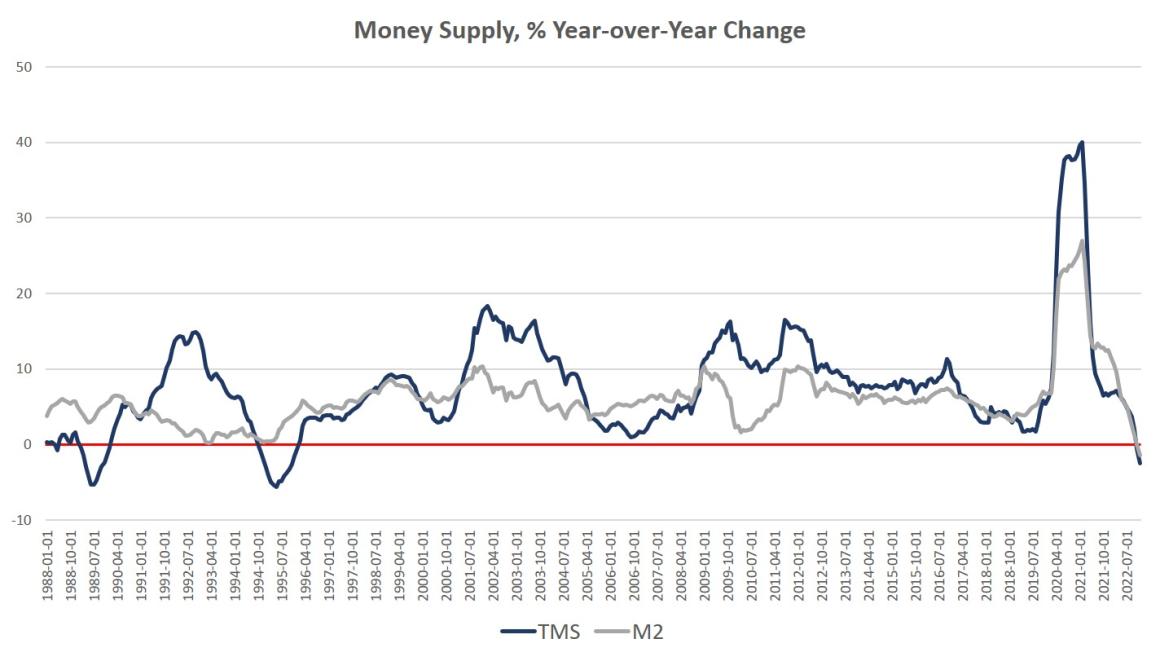| Money supply growth fell again in December, falling even further into negative territory after turning negative in November for the first time in twenty-eight years. December’s drop continues a steep downward trend from the unprecedented highs experienced during much of the past two years. During the thirteen months between April 2020 and April 2021, money supply growth in the United States often climbed above 35 percent year over year, well above even the “high” levels experienced from 2009 to 2013.
Since then, the money supply growth has slowed quickly, and since November, we’ve been seeing the money supply contract for the first time since the 1990s. The last time the year-over-year (YOY) change in the money supply slipped into negative territory was in November 1994. At that time, negative growth continued for fifteen months, finally turning positive again in January 1996. During December 2022, YOY growth in the money supply was at –2.4 percent. That’s down from November’s rate of –0.55 percent and down from December 2021’s rate of 6.44 percent. |
|
| The money supply metric used here—the “true,” or Rothbard-Salerno, money supply measure (TMS)—is the metric developed by Murray Rothbard and Joseph Salerno, and is designed to provide a better measure of money supply fluctuations than M2.1
The Mises Institute now offers regular updates on this metric and its growth. This measure of the money supply differs from M2 in that it includes Treasury deposits at the Fed (and excludes short-time deposits and retail money funds). In recent months, M2 growth rates have followed a similar course to TMS growth rates. In December 2022, the M2 growth rate was –1.3 percent. That’s down from November’s growth rate of –0.01 percent. December’s rate was also well down from December 2021’s rate of 12.5 percent. Money supply growth can often be a helpful measure of economic activity and an indicator of coming recessions. During periods of economic boom, money supply tends to grow quickly as commercial banks make more loans. Recessions, on the other hand, tend to be preceded by slowing rates of money supply growth. However, money supply growth tends to begin growing again before the onset of recession. |
|
| Negative money supply growth is not in itself an especially meaningful metric. But the drop into negative territory we’ve seen in recent months does help illustrate just how far and how rapidly money supply growth has fallen in recent months. That is generally a red flag for economic growth and employment.
Money supply growth also appears to be connected to yield-curve inversion—itself a recession indicator. For example, the 3s/10s yield spread often heads toward zero as money supply growth moves in the same direction. This was especially clear from 1999 through 2000, from 2004 to 2006, and during 2018 and 2019, and beginning in 2022. This is not surprising because trends in money supply growth have long appeared to be connected to the shape of the yield curve. As Bob Murphy notes in his book Understanding Money Mechanics, a sustained decline in TMS growth often reflects spikes in short-term yields, which can fuel a flattening or inverting yield curve. It’s not especially a mystery why short-term interest rates are headed up fast, and why the money supply is decelerating. Since January 2022, the Fed has raised the target federal funds rate from 0.25 percent up to 4.75 percent. |
This means fewer injections of Fed money into the market through open market operations. Moreover, although it has done very little to sizably reduce the size of its portfolio, the Fed has nonetheless stopped adding to its portfolio through quantitative easing and allowed a small amount (about 5 percent of $8.9 trillion) to roll off.
It should be emphasized that it is not necessary for money supply growth to turn negative in order to trigger recession, defaults, and other economic disruptions. With recent decades marked by the Greenspan put, financial repression, and other forms of easy money, the Federal Reserve has inflated a number of bubbles and zombie enterprises that now rely on nearly constant infusions of new money to stay afloat. For many of these bubble industries, all that is necessary for a crisis is a slowing in money supply growth, brought on by rising interest rates or a confidence crisis.
Numerous indicators now point toward recession along with the falling money supply and the inverted yield curve. The Leading Economic Index is in recession territory. Real wages have fallen for twenty-one months. Home builder confidence fell every month of 2022. The Philadelphia Fed’s manufacturing index has been negative since September. Home price growth has been cut in half. The fact that the money supply is actually shrinking serves as just one more indicator that the so-called soft landing promised by the Federal Reserve is unlikely to ever be a reality.
- 1. Beginning this month, I have slightly re-calculated all periods of the TMS measure presented here to conform to the changes suggested by Robert Murphy and Ryan Griggs in “The Inverted Yield Curve, Austrian Business Cycle Theory, and the True Money Supply,” Quarterly Journal of Austrian Economics 24, no. 4 (December 2021): 523–41.
Full story here Are you the author? Previous post See more for Next post
Tags: Featured,newsletter























